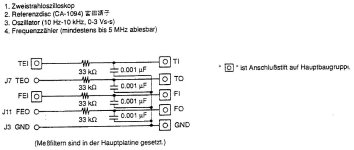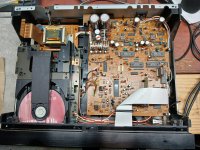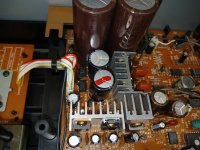Hi bxt,
Measure the battery voltage.
The 10K resistor prevents high current draw. That circuit provides a tiny draw to keep the memory alive, so you shouldn't see much drop across it. I've replaced a few lithium cells this way with 100 % success. Somewhere I have a cell with the resistor soldered on a lead, and other lead on another. That way I don't lose connection while changing the battery. A power supply risks a wire being pulled as you work.
At this point, ignore the cal seals.
Hi LJT,
I believe those are Philips transports. Look at the eye pattern firstly. Typical Philips type problems are capacitors going open, top to bottom PCB connections even on newer ones. The disc motor and table height are probably #1 most common issues. It can slide down the shaft.
If you get a VAM transport, pitch it. I had over 50% defect rate on new warranty replacements, the rest didn't perform well. Anything is better than a Philips VAM transport, even copies of Sony or Sanyo transports.
I used to align gain on the early Philips transports. Newer ones didn't have much in the way of adjustments. Someone in your area who did warranty should be able to help more. If you were here, no problem.
EDit:
Ahh, the NAD. That will be a cheap Chinese copy transport. Look up a new one on AliExpress and replace it.
Measure the battery voltage.
The 10K resistor prevents high current draw. That circuit provides a tiny draw to keep the memory alive, so you shouldn't see much drop across it. I've replaced a few lithium cells this way with 100 % success. Somewhere I have a cell with the resistor soldered on a lead, and other lead on another. That way I don't lose connection while changing the battery. A power supply risks a wire being pulled as you work.
At this point, ignore the cal seals.
Hi LJT,
I believe those are Philips transports. Look at the eye pattern firstly. Typical Philips type problems are capacitors going open, top to bottom PCB connections even on newer ones. The disc motor and table height are probably #1 most common issues. It can slide down the shaft.
If you get a VAM transport, pitch it. I had over 50% defect rate on new warranty replacements, the rest didn't perform well. Anything is better than a Philips VAM transport, even copies of Sony or Sanyo transports.
I used to align gain on the early Philips transports. Newer ones didn't have much in the way of adjustments. Someone in your area who did warranty should be able to help more. If you were here, no problem.
EDit:
Ahh, the NAD. That will be a cheap Chinese copy transport. Look up a new one on AliExpress and replace it.
For CD players, I have noticed that the old 3 CD changers neded to be level to play properly.
The Denon is a good set, when you use it, check with a spirit level that it is flat, side to side and front to back.
Use shims if needed.
That will prevent uneven tray wear, and alignment issues caused by that.
The Denon is a good set, when you use it, check with a spirit level that it is flat, side to side and front to back.
Use shims if needed.
That will prevent uneven tray wear, and alignment issues caused by that.
This isn't nearly as critical as you make it out. As long as things are reasonably level - you're good. The KSS-151A type transport (and Technics) are linear motors. These will be more sensitive to front-back level. You're fine as long as you are somewhat level.
Maybe really cheap machines might be sensitive, but I have yet to see any tray with uneven wear due to the unit not being level. Cheap machines have very light trays (don't confuse them with cup holders).
It ain't a turntable folks!
Maybe really cheap machines might be sensitive, but I have yet to see any tray with uneven wear due to the unit not being level. Cheap machines have very light trays (don't confuse them with cup holders).
It ain't a turntable folks!
Same with a Micromega stage2. Cleaned old grease end re-lubed but still picky on CDs it will play.
Assuming it still has the original Philips CDM12:4 pickup you have to strip these down completely removing the sled motor/worm gear and sled gear and thoroughly clean all old grease off these. Also the grease on the teeth of the rack fixed to the pickup has to be cleaned 100% completely. The slide has to be removed and washed and all grease cleaned from around the bushes the slide fits through on the pickup itself.
Reassemble using very small amount of a suitable 'plastics grease' that is plastic/metal compatible.
There are no guarantees but provided the pickup is original and not contaminated internally (the optics) it stands a good chance of success.
Replace power supply filter caps and adjust logic power supply to 4.9v .
This will help the most.
Even the cheapest CD mechanism makes essentially no errors and is bit accurate unless there are (big)scratches on the disk.
A $20 computer CD reader makes an exact copy to the hard drive, at 20x normal speed as well.
This will help the most.
Even the cheapest CD mechanism makes essentially no errors and is bit accurate unless there are (big)scratches on the disk.
A $20 computer CD reader makes an exact copy to the hard drive, at 20x normal speed as well.
Hi stocktrader200,
I am sorry, but what you just stated is so far from true I can't let it stand. CD mechanisms do not read perfectly, not even close. There are HUGE differences between them.
The signal from the CD is an analogue RF signal that contains noise, dropouts and many errors. You used to be able to monitor the error rate from the C1 and C2 flag outputs. The C2 flag means the data is too corrupted to ever reconstruct. C1 is an error flag, it's busy.
One fantastic indicator of error rate (BLER) aside from the flags, is the quality of the RF (EYE) pattern. It should be clean without noise, stable vertically and horizontally. The only CD transport that produced results like that was made by NEC, Alpage and Nakamichi used it. Maybe others brands used it, but it was a very expensive transport. The digital information is detected by sampling the analogue RF waveform at specific time intervals and the level determined a high or low. Therefore, noise and jitter plus level changes create incorrect detections.
CD transports going forward from that time degraded mechanically with the resulting impairments of the RF pattern. Servos got better as did DSP. By the way, the original named purpose of the DSP chip was "Error detection, correction and concealment". They dropped the concealment part and buried the C1 and C2 flags so they couldn't be monitored. Hiding the truth in other words.
The data stream from the DSP is always correct in as much as it doesn't violate the rules for valid data. But. That data is often NOT was was encoded on the disc. Sometimes it is a digital mute, repeated data or the better ones interpolate between adjacent values - if they can.
Computer data is not encoded the same way music is. There is far more robust error correction involved, and it will attempt to re-read an error. That doesn't mean it is better, far from it!
So for music, the better transport when aligned and working properly produces far fewer data errors than a cheaper or computer drive. Feed a DAC a data stream with plenty of actual data errors and you get poorer sound quality, period. The data is error free as a data stream is concerned, but it is not error free as far as what was stamped on the disc. Do not confuse computer data with music data. Not the same thing at all.
My advice. Don't mess with it as far as electrical is concerned. It's running fine. Sort out belts, clean and lubricate it. Use the correct lubricants. These machines were designed conservatively and your power supply is likely fine. Why tempt fate?
I am sorry, but what you just stated is so far from true I can't let it stand. CD mechanisms do not read perfectly, not even close. There are HUGE differences between them.
The signal from the CD is an analogue RF signal that contains noise, dropouts and many errors. You used to be able to monitor the error rate from the C1 and C2 flag outputs. The C2 flag means the data is too corrupted to ever reconstruct. C1 is an error flag, it's busy.
One fantastic indicator of error rate (BLER) aside from the flags, is the quality of the RF (EYE) pattern. It should be clean without noise, stable vertically and horizontally. The only CD transport that produced results like that was made by NEC, Alpage and Nakamichi used it. Maybe others brands used it, but it was a very expensive transport. The digital information is detected by sampling the analogue RF waveform at specific time intervals and the level determined a high or low. Therefore, noise and jitter plus level changes create incorrect detections.
CD transports going forward from that time degraded mechanically with the resulting impairments of the RF pattern. Servos got better as did DSP. By the way, the original named purpose of the DSP chip was "Error detection, correction and concealment". They dropped the concealment part and buried the C1 and C2 flags so they couldn't be monitored. Hiding the truth in other words.
The data stream from the DSP is always correct in as much as it doesn't violate the rules for valid data. But. That data is often NOT was was encoded on the disc. Sometimes it is a digital mute, repeated data or the better ones interpolate between adjacent values - if they can.
Computer data is not encoded the same way music is. There is far more robust error correction involved, and it will attempt to re-read an error. That doesn't mean it is better, far from it!
So for music, the better transport when aligned and working properly produces far fewer data errors than a cheaper or computer drive. Feed a DAC a data stream with plenty of actual data errors and you get poorer sound quality, period. The data is error free as a data stream is concerned, but it is not error free as far as what was stamped on the disc. Do not confuse computer data with music data. Not the same thing at all.
My advice. Don't mess with it as far as electrical is concerned. It's running fine. Sort out belts, clean and lubricate it. Use the correct lubricants. These machines were designed conservatively and your power supply is likely fine. Why tempt fate?
Hi Anatech, as CD is a data format and music is 16bit 44.1khz the mechanism that reads it must be bit accurate for a computer. If the audio data does not require perfect data reproduction would that not result in more skips and stoppages as the data is read in blocks and a bad block could stop the player or cause a thump.
If the errors are many small ones the DAC should see that as noise lowering the S/N ratio.
If the errors are many small ones the DAC should see that as noise lowering the S/N ratio.
Nope. I'm afraid that isn't how it works.
The data encoding for computer data is different than music data. Data errors won't cause the transport to stop, but a loss of RF signal will cause the servos to unlock and hopefully stop.
The encoding for data is far more robust than for audio music. Two completely different systems.
The data encoding for computer data is different than music data. Data errors won't cause the transport to stop, but a loss of RF signal will cause the servos to unlock and hopefully stop.
The encoding for data is far more robust than for audio music. Two completely different systems.
check this maybe you can make the sound better
Very often when looking into DACs, CD players, Amps with regulators the capacitors between the legs of 78xx and 79xx were missing!
Just adding appropiate C's due to dratashhet made the sound much better.
Just adding appropiate C's due to dratashhet made the sound much better.
What would one expect a battery to last 3457a? I know that's a loaded question, but axp how many yrs?Hi bxt,
Measure the battery voltage.
The 10K resistor prevents high current draw. That circuit provides a tiny draw to keep the memory alive, so you shouldn't see much drop across it. I've replaced a few lithium cells this way with 100 % success. Somewhere I have a cell with the resistor soldered on a lead, and other lead on another. That way I don't lose connection while changing the battery. A power supply risks a wire being pulled as you work.
At this point, ignore the cal seals.
Also, on the 1520 filter boxes. There is nothing that I have seen stating capacitor or resistor values in the service manual. The copy from hifi, I am not sure is the complete service manual. You mentioned you might have access to that info? thks?
Go for good quality batteries...Toshiba, SAFT, Tadiran and Panasonic are better than most Chinese batteries. No ties, just well known names.
A similar meter repair job, found on the net (no ties):
http://mrmodemhead.com/blog/hp-3468a-battery-replacement/
A similar meter repair job, found on the net (no ties):
http://mrmodemhead.com/blog/hp-3468a-battery-replacement/
Thanks for all the help.
The multimeter I purchased was used, and was last certified 12 yrs ago. I had it over a year/two now and only used for special uses. I never opened it up and if I did, I would like to change out the battery. The link is very useful.
Will be diving into this CD player this week, as the belts & special lubes will be here monday or tue. thks
The multimeter I purchased was used, and was last certified 12 yrs ago. I had it over a year/two now and only used for special uses. I never opened it up and if I did, I would like to change out the battery. The link is very useful.
Will be diving into this CD player this week, as the belts & special lubes will be here monday or tue. thks
I don't anticipate you having any problems replacing the battery in your 3457A. I bought mine from Digikey, so good quality. Just make solid solder connections with the "keep alive" battery when you work, unplug the 3457A before doing anything so a grounded station doesn't dump your memory. I'd replace the battery sooner than later to avoid having a recalibration required. HP / Agilent / Keysight tends to hold calibration for a very long time. None of my 34401A meters were ever out of tolerance when tested, same for my 3456A or 3457A meters. Even the 3478A meters stayed in tolerance as long as the battery didn't die. I had two 3478A and one 3457A battery die.
TAke your time wit hthe DCD-1520. Be observant and think. Never do anything you can't come back from.
TAke your time wit hthe DCD-1520. Be observant and think. Never do anything you can't come back from.
Was happy to find my old Narvina dsk, but zoom in the left by the filter caps starting close by chips and to the right. All leaking some weird purple stuff? I guess electrolytics. Never seen purple, hope the board cleans up. By the left those chips look dark in the area. 🙁
Attachments
Here's a different angle. Looks like I might be able to clean off with heat. Possibly something to hold the caps?
Attachments
Last edited:
- Home
- Source & Line
- Digital Source
- Denon DCD-1520 opamps change


